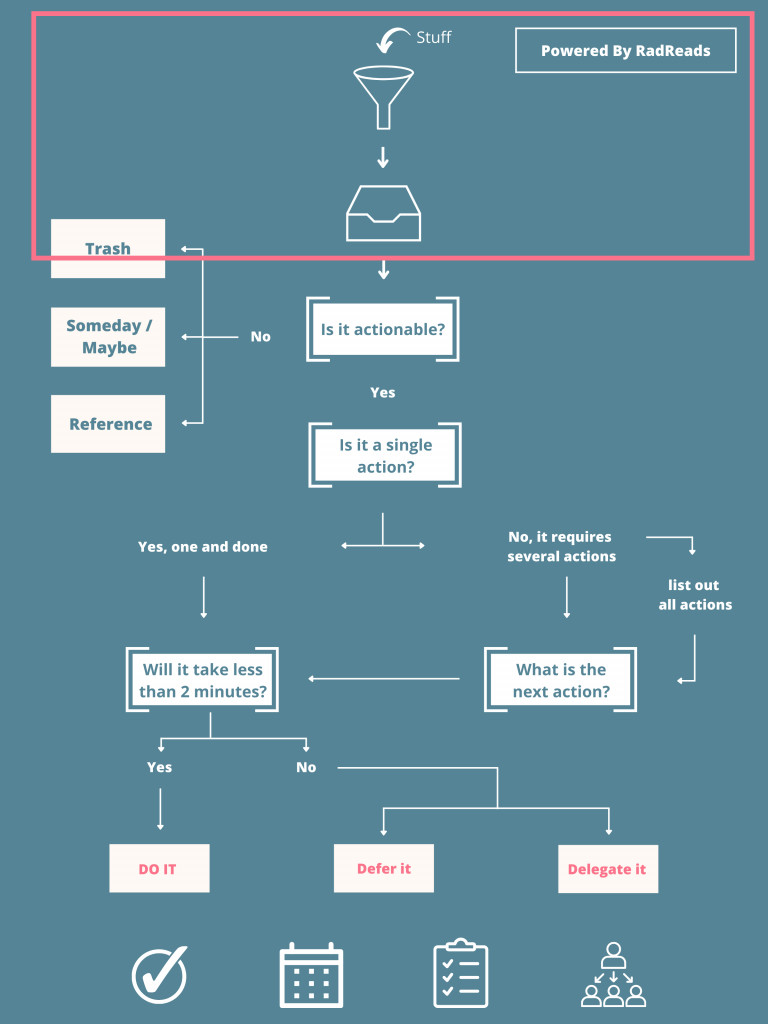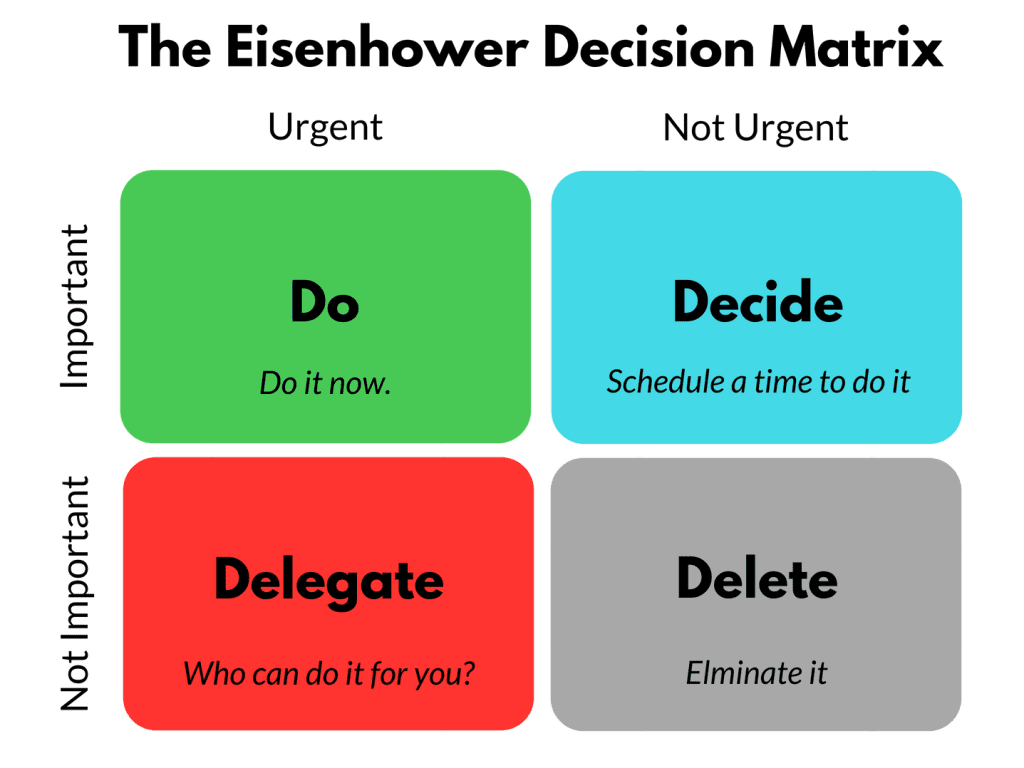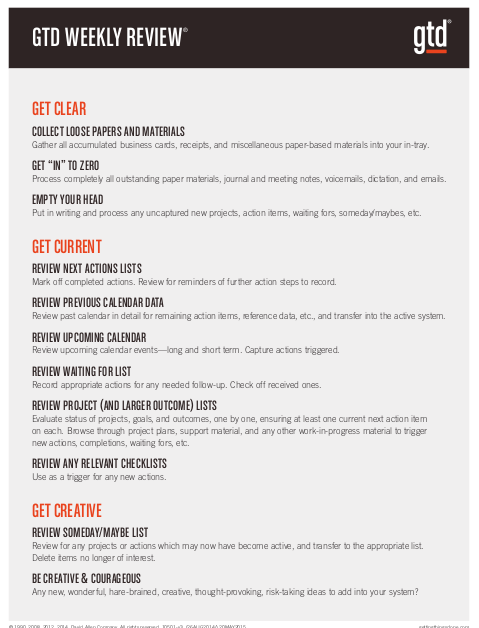Implementing GTD method in real life
start transforming your life from today
If you track your time properly, you will notice you are probably suffering from a massive load of information gathered throughout our day and can’t find out any ways to really absorb that knowledge efficiently?
In fact, an average person consumes about 34 gigabytes of data & information daily(about 100,000 words heard everyday). Due to this fact, it is really showing how you can actually spend your social media time very mindlessly if you are not taking account of it.
In this article, I am going to briefly explains about GTD method and some implication of these concepts to make use of them the most.
References
GTD(Getting Things Done)
Getting things done(GTD) is considerably the first ever productivity system that could pretty much act as your second brain. By definition, second brain is something that could efficiently store information and reminders in an external source outside of your brain.
Because GTD is a second brain system, it has pretty systematic structure for actually organizing your daily life specifically about managing your time and notes.
In addition, there are actually five main most important underlying process behind GTD. There are:
Capture
Clarify
Organize
Review
Engage
I am going to breakdown each of these section and give you quite a detail view about how these processes actually mean.
1. Capture
This term ‘capture’ literally means that you should be inputting these articles or knowledge into some sort of external system. Personally, I use an app called Google Task which is exceptionally useful in dealing with tasks and projects. Also, if I want to process some notes or some ideas, I use an additional note taking system called Zettelkasten method which I will later talk about in my following articles.
2. Clarify
This is something concerned with something called Next Action list. Basically, this means you should batch your tasks ie categorize your tasks in different categories. In GTD, they cover 5 different categories:
Home
Errand
Read&Review
Computer(ie Internet)
Waiting for(categorized with people)
3. Organize
If you have used “organizer”, it would not be strange to actually implement this idea. Organizer mean a small cupboard that have different drawers which you can label and make it really easy for you to search information. By deriving this metaphor or the concept, organizing is more like different categories or batches that include same or similar items or information.
In GTD, there is actually this flow chart which concisely indicate the flow of your work and categories to be organized to make that workflow.
Source: https://radreads.co/wp-content/uploads/2022/08/GTD-Flowchart-1-768x1024.png
When you look at this chart, obviously this is the part where you have to clarify thing in a concise manner. However, I think this concerns with organizing because if and only if you have organized your detail categories in a precise system, you will be able to batch those tasks properly(make a proper delegation and a proper deferral). Now, I will be going through how you can use the 5 most indispensable organizational categories when you implement this GTD in reality.
Trash
This is where you find this information unhelpful or unnecessary, so you dump this in trash categories or delete the task in GOOGLE TASK while going through the inbox.
Someday / Maybe
This is a special feature I think that David Allen has actually developed. It is like a place where you write down what you want to do or have wishes for but could not get started. This thing don’t need any kind of categorical management or batching because it is impossible to find something that intersect with what most people are focusing on because it is not something that is aligned to privileges that people possess.
However, it would be fantastic to use some of the ideas for a someday/maybe list(sm list in short).
What to do
What to buy
What to learn
Where to go
What to use(something like what to do but to use it daily after possessing it)
Reference
Actually, this is the part where I would recommend checking out zettelkasten method online and I am also going to upload that article on my website. So, if it has released you can find it in the archive page. I don’t really think an article could cover everything. But also recommend taking a portion of some of what Ali Abadaal said in his magical framework(5 magical apps that changed his life).
Calendar
This is what most people have thought of in detail even without having a concise step-by-step and back-to-back productivity system. For most people, this is either a schedule or a piece of paper that has activities associated.
In GTD, there is no subtle difference in term of its functionalities or usage but there are actually different in reviewing stage or different perspective of the calendar. Therefore, I will only over some of the reviewing step later.
However, most importantly, GTD is all about deferring tasks in quite a detail way with the tasks actually organized with those next action lists.
Waiting for
This is a delegation next action list where you have different people assigned as different batches to interact with or delegate tasks.
Eisenhower matrix
This is also something optional but actually a powerful tool to use especially when you are dealing with tasks that you must do. This is I think sort of an additional layer to make your task organized especially when processing with to-do list and things like that.
Source: https://luxafor.com/wp-content/uploads/2023/02/The-Eisenhower-Decision-Matrix-png.png.webp
What I would recommend is to process your calendar every night to prepare for tomorrow and use that eisenhower matrix while processing tasks and put those urgent tasks in your to-do list depending on whether you must not actually do it now or not.
4. Review
This is the part where you actually come across the idea of reviewing like the business where you will be going through spreadsheets of stock and priortize what to actually sell.
In GTD, this metaphorical concept will actually applies explicitly if you are actually willing to convert your 34 GB of information into something that is useful for your future references and career improvement. It is recommend to review your weekly tasks depending on which day you want to review those tasks.
Source: gettingthingsdone.com
Like being flexible is the key to success, to be flexible, you need to constantly learn new knowledge. Therefore, it is important to learn new productivity tools out there or use chatgpt to find out new tools easier. Place it in your weekly review and synergize it with your flow chart.
5. Engage
This is the part where I will be giving you quite a detail instruction about how to implement this in reality and how do you make yourself feel energetic to take all these overwhelming work.
First of all, the real thing you need for your key success is willingness and time. Personally, when I was going through this journey, I didn’t really get to know all the advantages and subtleties even after reading David Allen 2001 published GETTING THINGS DONE book. Therefore, I do think what you really need to do now is just to focus on getting started and I will be uploading additional main key ideal point that I come across from those productivity failures and mistakes.
Biologically speaking, I think there are 2 different mode that are especially important for learning things. These are focus mode and diffuse mode.
Focus mode is essentially where you sit down and decided to focus on one single task and you end up with quite a decent amount of time passed without you noticing any other signals. The best example might be playing video games and trying to level up your character by trying your best.
Diffuse mode is essentially where we would be doing nothing but fall asleep in endless thought about different ideas and concepts. In psychological nomenclature, this is divergent thinking when alpha waves flow flawlessly in EEG(electroencephalogram). After my normal ritual of interleaving of focus mode and diffuse mode, I found out that alpha waves flow most when you take a shower or take a bath.
How do these 2 modes come in action?
In reality, it is actually properly the best way to avoid procrastination(hesitating the action by delaying it) and the most efficient way is POMODORO TIMER.
POMODORO TIMER is actually transforming your focus session into long sessions compacted with short sessions and short breaks. Traditionally, it was 25 minute focus session and 5 minute break but the better technique to also chunk your session into hours is something called TOCK TIMER.
TOCK TIMER is a long session compacted with 45 minute short sessions and 15 minute breaks.
Note that in break time, make sure you don’t watch any screen especially phone because small screen including TV can make you get into focus mode.
Summary
If you have followed along just make sure you keep learning and experimenting with different systems to get the best out of everything but GTD is the best one I have found out in term of framework which can fit in multiple system into one.
Finally, if you have any questions, feel free to leave them in the comment down below and also make sure you answer these questions in the comment down below as well:
What are the steps you take in each stage of GTD and explain it with numbered list.
What are the systems you discovered other than GTD and zettelkasten method?
What is your opinion on GTD




